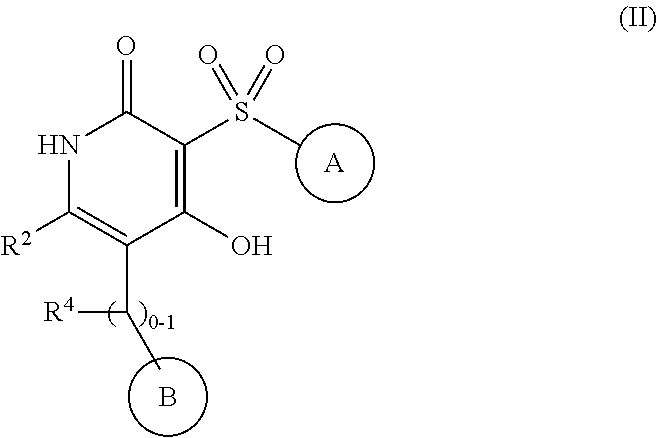4-hydroxy-3-sulfonylpyridin-2(1H)-ones as apj receptor agonists
a technology of sulfonylpyridine and receptor, applied in the field of sulfonylpyridine compounds, can solve the problems of poor prognosis, only 50% survival rate, and impaired quality of li
- Summary
- Abstract
- Description
- Claims
- Application Information
AI Technical Summary
Benefits of technology
Problems solved by technology
Method used
Image
Examples
example 1
6-butyl-5-(2,6-dimethoxyphenyl)-3-((4-(2-fluoro-3-methylpyridin-4-yl)phenyl)sulfonyl)-4-hydroxypyridin-2(1H)-one
[0321]
Compound 1a. Ethyl 2-(2,6-dimethoxyphenyl)acetate
[0322]To a solution of 1,3-dimethoxybenzene (3.3 mL, 25 mmol) in THF (40 mL) was added dropwise 2.5M nBuLi in hexanes (10 mL, 25 mmol) over a 10 min period then the reaction mixture was stirred for 2 h. Crushed copper(I) iodide (2.38 g, 12.5 mmol) was added slowly then the reaction mixture stirred for 1 h, turning homogeneous. The reaction mixture was cooled to −78° C. then ethyl bromoacetate (2.8 mL, 25 mmol) was added dropwise over 20 min. The cold bath was removed and the reaction mixture allowed to warm to room temperature. The reaction mixture was quenched by the addition of water then Et2O added and the mixture filtered through celite. The filtrate was diluted with 1.5N K2HPO4 and extracted with Et2O (2×). The combined organic extracts were washed with brine, dried (MgSO4) filtered and concentrated under reduced ...
example 1.6
Example 1. 6-butyl-5-(2,6-dimethoxyphenyl)-3-((4-(2-fluoro-3-methylpyridin-4-yl)phenyl)sulfonyl)-4-hydroxypyridin-2(1H)-one
[0329]The mixture of Compound 1g (10 mg, 0.019 mmol), (2-fluoro-3-methylpyridin-4-yl)boronic acid (8.9 mg, 0.057 mmol) and Pd-XPhos G3 (1.22 mg, 0.001 mmol) in THF (1 mL) was added phosphoric acid, potassium salt (0.5 M) (0.077 mL, 0.038 mmol). The reaction mixture was flushed with nitrogen for 5 min and heated in microwave reactor at 120° C. for 30 min. The reaction mixture was concentrated, diluted with DMF and purified by reverse phase HPLC to give Example 1 (6.3 mg, 57% yield). MS m / z=553.1 (M+H) (Method B, Rt=1.87 min). 1H NMR (500 MHz, DMSO-d6) δ 8.20-8.06 (m, 3H), 7.68 (d, J=7.3 Hz, 2H), 7.30 (d, J=5.2 Hz, 2H), 6.71 (d, J=8.2 Hz, 2H), 3.69 (s, 6H), 2.17 (s, 3H), 2.06 (d, J=5.5 Hz, 2H), 1.27 (d, J=7.3 Hz, 2H), 1.05 (d, J=7.3 Hz, 2H), 0.62 (t, J=7.3 Hz, 3H). Human APJ cAMP EC50 Potency range A.
[0330]The following compounds, Example 2 to Example 18, were pre...
example 19
6-Butyl-3-((4-(5-chloro-2-oxopyridin-1 (2H)-yl)phenyl)sulfonyl)-5-(2,6-dimethoxyphenyl)-4-hydroxypyridin-2(1H)-one
[0331]
[0332]A mixture of 5-chloropyridin-2(1H)-one (29.8 mg, 0.23 mmol) and anhydrous copper(II) acetate (20.9 mg, 0.12 mmol) was dissolved in dry DMSO (1.0 mL). Compound 1g (30 mg, 0.057 mmol) and DBU (0.034 mL, 0.23 mmol) were added under nitrogen. The vial was sealed and heated at 130° C. for 18 h. The reaction mixture was purified by reverse phase HPLC to give Example 19 (10 mg, 30.5% yield). MS m / z=571.0 (M+H) (Method A, Rt=0.95 min). 1H NMR (500 MHz, CDCl3) δ11.50 (s, 1H), 8.36-8.29 (m, J=8.5 Hz, 2H), 7.64-7.55 (m, J=8.5 Hz, 2H), 7.46-7.35 (m, 3H), 6.71-6.62 (m, 3H), 3.79 (s, 6H), 2.28-2.21 (m, 2H), 1.33-1.18 (m, 4H), 0.79 (t, J=7.3 Hz, 3H). Human APJ cAMP EC50 Potency range A.
[0333]The following examples, Example 20 to Example 26, were prepared by the general procedures described for Example 19.
PUM
 Login to View More
Login to View More Abstract
Description
Claims
Application Information
 Login to View More
Login to View More - R&D
- Intellectual Property
- Life Sciences
- Materials
- Tech Scout
- Unparalleled Data Quality
- Higher Quality Content
- 60% Fewer Hallucinations
Browse by: Latest US Patents, China's latest patents, Technical Efficacy Thesaurus, Application Domain, Technology Topic, Popular Technical Reports.
© 2025 PatSnap. All rights reserved.Legal|Privacy policy|Modern Slavery Act Transparency Statement|Sitemap|About US| Contact US: help@patsnap.com



